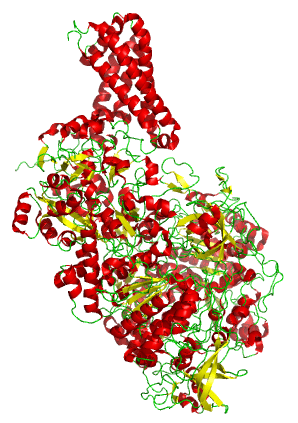EC number 1.7.99.4 ExPASy NiceZyme view | CAS number 37256-45-4 | |
 | ||
Nitrate reductases are molybdoenzymes that reduce nitrate (NO−
3) to nitrite (NO−
2). This reaction is critical for the production of protein in most crop plants, as nitrate is the predominant source of nitrogen in fertilized soils.
Contents
Eukaryotic
Eukaryotic nitrate reductases are part of the sulfite oxidase family of molybdoenzymes. They transfer electrons from NADH or NADPH to nitrate.
Prokaryotic
Prokaryotic nitrate reductases belong to the DMSO reductase family of molybdoenzymes and have been classified into three groups, assimilatory nitrate reductases (Nas), respiratory nitrate reductase (Nar), and periplasmic nitrate reductases (Nap). The active site of these enzymes is a Mo ion that is bound to the four thiolate functions of two pterin molecules. The coordination sphere of the Mo is completed by one amino-acid side chain and oxygen and/or sulfur ligands. The exact environment of the Mo ion in certain of these enzymes (oxygen versus sulfur as a sixth molybdenum ligand) is still debated. The Mo is covalently attached to the protein by a cysteine ligand in Nap, and an aspartate in Nar.
Structure
The transmembrane respiratory nitrate reductase (EC) is composed of three subunits; an alpha, a beta and two gamma. It is the second nitrate reductase enzyme which it can substitute for the NRA enzyme in Escherichia coli allowing it to use nitrate as an electron acceptor during anaerobic respiration.
Nitrate reductase gamma subunit resembles cytochrome b and transfers electrons from quinones to the beta subunit.
The nitrate reductase of higher plants is a cytosolic protein. There exists a GPI-anchored variant that is found on the outer face of the plasma membrane. Its exact function is still not clear.
A transmembrane nitrate reductase that can function as a proton pump (similar to the case of anaerobic respiration) has been discovered in a diatom Thalassiosira weissflogii.
Catalytic mechanism
Nitrate molecule binds to the active site with the Mo ion in the +6 oxidation state. Electron transfer to the active site occurs only in the proton-electron transfer stage, where the MoV species plays an important role in catalysis. The presence of the sulfur atom in the molybdenum coordination sphere creates a pseudo-dithiolene ligand that protects it from any direct attack from the solvent. Upon the nitrate binding there is a conformational rearrangement of this ring that allows the direct contact of the nitrate with MoVI ion. This rearrangement is stabilized by the conserved methionines Met141 and Met308. The reduction of nitrate into nitrite occurs in the second step of the mechanism where the two dimethyl-dithiolene ligands have a key role in spreading the excess of negative charge near the Mo atom to make it available for the chemical reaction. The reaction involves the oxidation of the sulfur atoms and not of the molybdenum as previously suggested. The mechanism involves a molybdenum and sulfur-based redox chemistry instead of the currently accepted redox chemistry based only on the Mo ion. The second part of the mechanism involves two protonation steps that are promoted by the presence of MoV species. MoVI intermediates might also be present in this stage depending on the availability of protons and electrons. Once the water molecule is generated only the MoVI species allow water molecule dissociation, and, the concomitant enzymatic turnover.
Applications
Nitrate reductase activity can be used as a biochemical tool for predicting grain yield and grain protein production.
Nitrate reductase promotes amino acid production in tea leaves. Under south Indian conditions, it is reported that tea plants sprayed with various micronutrients (like Zn, Mn and B) along with Mo enhanced the amino acid content of tea shoots and also the crop yield.
